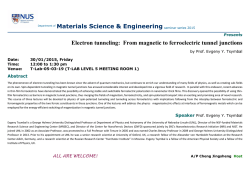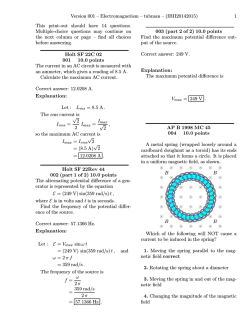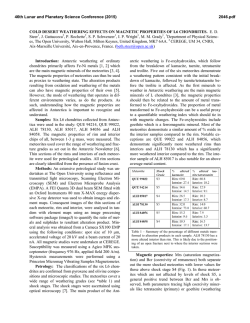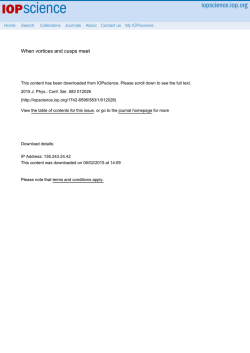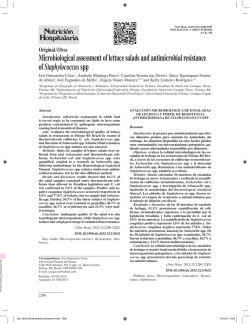
Electronic and Magnetic Structures of Sr2FeMoO6
Electronic and Magnetic Structures of Sr2 FeMoO6 Sugata Ray,1 Ashwani Kumar,1 D. D. Sarma,1, * R. Cimino,2 S. Turchini,3 S. Zennaro,4 and N. Zema5 1 Solid State and Structural Chemistry Unit, Indian Institute of Science, Bangalore 560 012, India 2 Istituto Nazionale di Fisica Nucleare – Laboratori Nazionali di Frascati, Italy 3 Istituto di Chimica dei Materiali, CNR–Area della Ricerca di Montelibretti, Roma, Italy 4 Istituto di Struttura della Materia, CNR, sezione Trieste, Trieste, Italy 5 Istituto di Struttura della Materia, CNR-Area della Ricerca di Tor Vergata, Roma, Italy We have investigated the electronic and magnetic structures of Sr2 FeMoO6 employing site-specific direct probes, namely x-ray absorption spectroscopy with linearly and circularly polarized photons. In contrast to some previous suggestions, the results clearly establish that Fe is in the formal trivalent state in this compound. With the help of circularly polarized light, it is unambiguously shown that the moment at the Mo sites is below the limit of detection ͑,0.25 mB ͒, resolving a previous controversy. We also show that the decrease of the observed moment in magnetization measurements from the theoretically expected value is driven by the presence of mis-site disorder between Fe and Mo sites. The observation of colossal magnetoresistance (CMR) in the perovskite mixed valent manganites has led to a renewed interest in ferromagnetic oxides. It is believed that the double exchange mechanism in the presence of strong electron-phonon couplings arising from Jahn-Teller distortions is responsible for the observed properties in the manganites [1]. Recently, double perovskite Sr2 FeMoO6 was established as a new CMR material [2]. This compound, in contrast to the manganites, has certain technologically desirable properties, such as a substantial MR at a low applied field even at room temperature. From a fundamental point of view, it is even more important to note that crystallographic data do not indicate any substantial JT distortion and the lattice does not appear to play any significant role in this compound. Furthermore, the system is an undoped one in contrast to the manganites. Thus, Sr2 FeMoO6 is in principle a simpler system to understand its properties in detailed theoretical terms. In spite of this apparent simplicity, there are surprisingly many open issues concerning the basic electronic and magnetic structures of this compound. In this compound, each of the Fe31 ͑S 5͞2͒ and Mo51 ͑S 1͞2͒ sublattices are believed to be arranged ferromagnetically, while the two sublattices are coupled to each other antiferromagnetically. It has been suggested [2] that the system is in a half metallic ferromagnetic (HMFM) state. However, there appear to be several controversies concerning the real nature of this compound. One neutron diffraction study [3] reported the absence of any moment at the Mo sites, suggesting Mo to be essentially nonmagnetic, whereas another study [4] suggested ϳ1 mB at each Mo site. Moreover, analysis of Mössbauer results have been interpreted both in terms of Fe31 [5,6] and Fe2.51 [7] states. Thus, it is obvious that even the basic issues concerning the electronic and magnetic structures of this compound have not been settled so far. Since the analysis of neutron and Mössbauer data are model dependent, it is obviously necessary to obtain site-specific direct informa- tion concerning the electronic and magnetic properties of this compound. Additionally, in the originally proposed magnetic structure [2], the system is expected to have a moment of 4 mB per formula unit (f.u.) due to the ferrimagnetic coupling between the Fe31 3d 5 and Mo51 4d 1 configurations. However, the observed saturation magnetization ͑MS ͒ is often found [2,8,9] to be about 3 mB ͞f.u. We address all these issues combining linear and circularly polarized x-ray absorption spectroscopy (XAS), with its ability to provide direct, site-specific electronic and magnetic information. In addition to providing the magnetic structure of this compound and explaining the reduction in the observed moment, our results also suggest that this compound cannot be described within the conventional double exchange mechanism. Sr2 FeMoO6 can exist with a varying extent of mis-site disorder between the Fe and Mo sublattices. Synthesis and characterization of highly ordered (ϳ90%) and extensively disordered (ordering of ϳ30%) Sr2 FeMoO6 have been described in our earlier publication [6]. The experiments were carried out at the 4.2R circularly polarized beam line at Elettra Synchrotron Radiation Facility. The measurements were performed at 77 K, which is well below the magnetic ordering temperature (ϳ420 K) [10]. The sample surface was cleaned in situ by scraping with a diamond file. The degree of circular polarization at the relevant photon energy was approximately 85%. In order to address the valence state of Fe in such oxides, it is most suitable to probe the Fe 2p3͞2 ͑L3 ͒ XAS which exhibits very clear differences between formal Fe21 and Fe31 states. Specifically, the 2p3͞2 absorption edge of all Fe21 species in an octahedral crystal field exhibits a main peak at a lower energy, followed by a weaker peak or shoulder at a higher energy. The ordering of the peaks is reversed for Fe31 species [11] providing an easy way to identify the formal Fe valence state independent of the extent of covalency. We have recorded a high resolution (ϳ0.3 eV) Fe 2p3͞2 absorption spectrum of Sr2 FeMoO6 with linearly polarized light (Fig. 1). From this figure, it is evident, even in absence of any detailed analysis that only a Fe31 valence state is consistent with the experimental result, exhibiting a weaker lower energy shoulder and a higher energy main peak. However, in order to provide a quantitative description of the spectral features and, more importantly, of the ground state, it is important to carry out detailed calculations including hybridization effects with the ligands within a cluster model on an equal footing as core-valence and valence-valence multiplet interactions and crystal-field effects, as the participation of the ligand levels in determining the spectral features may be significant [12]. In order to minimize the number of free parameters, we fix the multi4 2 2 (9.7 eV), Fdd (6.1 eV), Fpd plet interaction strengths, Fdd 1 3 (5.4 eV), Gpd (3.9 eV), and Gpd (2.2 eV) to 80% of the atomic Hartree-Fock values to account for the solid state screening. Additionally, the hopping parameter strengths, pds, pdp, and pps of 21.7, 0.9, and 0.45 eV, respectively, are guided by a tight-binding fitting [13] of the spin-polarized ab initio band dispersions. Moreover, we fix the multiplet averaged 2p core–3d valence Coulomb interaction strength, Upd , to be 1.2 times that of Udd between the 3d electrons, according to the usual practice. Thus, we are left with only two adjustable parameters, namely Udd and the O 2p– Fe 3d charge transfer energy, D. Since the resulting many-body problem within a complete basis approach [12] involves nearly 30 000 basis states, the calculations were carried out within the Lanczos algorithm. We obtain a remarkably good description of the spectral features with Udd 4 eV and D 3 eV for the Fe31 configuration, as shown in Fig. 1. Udd and D estimated here are consistent with those in other octahedral Fe31 oxides. The many-body ground state has 60.2% d 5 , 34.5% d 6 L1 , and 5.1% d 7 L2 character, suggesting the system to be somewhat more ionic than even LaFeO3 [14]. It should be noted here that it was not possible to describe the spectral features at all starting with a formal Fe21 configuration and then including configuration interaction for any choice of parameter strengths, conclusively establishing the 31 valence state of Fe in Sr2 FeMoO6 . While the XAS with linearly polarized light at the Fe 2p edge provides a definitive description of the site-specific electronic structure, it is not as specific to the magnetic structure as x-ray magnetic circular dichroism (XMCD) results would be. In order to specifically investigate the magnetic structure, we have carried out XAS at the Fe 2p and Mo 3p edges with circularly polarized light. We use a lower resolution (ϳ1.0 eV at the Fe 2p edge) to improve substantially the signal-to-noise ratio, though this smoothens out the detailed spectral features which are very similar to those with linearly polarized light (Fig. 1). In Fig. 2(a), we show the photon-flux normalized polarization-dependent Fe 2p XAS spectra, m1 and m2 for highly ordered Sr2 FeMoO6 , corresponding to the helicity parallel and antiparallel to the Fe 3d majorityspin direction, respectively. The XMCD spectrum, ᭝m m1 2 m2 , also shown in the same panel, clearly exhibits a substantial magnetic signal, indicative of a large Fe moment. The corresponding experimental m1 , m2 , and ᭝m spectra for Mo 3p edge are shown in Fig. 2(b). It is evident from the XMCD spectrum of Mo that any magnetic moment at these sites is below the detection limit (,0.25 mB ). The present result is in clear contradiction with the suggestion of a measurable moment (ϳ1 mB ) at the Mo sites [2,4], while it is in agreement with a previous neutron diffraction measurement [3] where no moment could be detected at the Mo sites. The above results, in conjunction with already known properties of Sr2 FeMoO6 , provide an understanding of the (a) Fe 2p µ µ µ − + µ −µ + Intensity (arb. units) Intensity (arb. units) Fe 2p3/2 XAS (b) Mo 3p + µ − + − + µ −µ − − ∫L + L (µ −µ ) dε 3 2 Experimental x2 680 Calculated 684 686 688 690 692 694 hν (eV) FIG. 1. Experimental and calculated Fe 2p3͞2 x-ray absorption spectrum for ordered Sr2 FeMoO6 . 690 700 hν (eV) 710 370 380 390 400 410 420 hν (eV) FIG. 2. X-ray absorption spectra at (a) Fe 2p, and (b) Mo 3p edges for ordered Sr2 FeMoO6 , measured using circularly polarized light. Circular dichroism signals, the difference between the absorption for right and left circularly polarized light at these edges, are also shown. The Mo difference spectrum is multiplied by 2 for clarity. The integral difference spectrum for Fe 2p edge is also shown in (a). expected on the basis of the simple ionic picture, in all reported results. In this context, it is important to note that Sr2 FeMoO6 always appears with a finite concentration of mis-site disorder where a pair of Fe and Mo exchange their crystallographic positions. The best compounds have been reported to have ϳ90% ordering of the Fe and the Mo sites [2,6]. In order to investigate whether such a mis-site disorder can be responsible for the observed reduction of the moment from the ideal value of 4 to about 3 mB and whether the reduction in the total magnetization is related to a corresponding loss in the local magnetic moment of Fe, we have also recorded the XAS at the Fe 2p edge of the extensively disordered Sr2 FeMoO6 with circularly polarized light. These spectra along with the XMCD result at the Fe 2p edge for the disordered sample are shown in Fig. 3, while in inset I, we compare the XMCD signals, normalized by the corresponding total area of the sum (m1 1 m2 ) spectrum, from the ordered and disordered Sr2 FeMoO6 . It is evident from the spectra that the magnetic moment on individual Fe ions decreases remarkably with decreasing ordering. In order to quantify our results, we have calculated the orbital, spin, and total moments at the Fe sites from these spectra with the assumption of negligible magnetic-dipole moment, using the well-established sum rules [18,19]. All the individual spin, orbital, and total moments of these two samples are shown in Table I. In these cases, we find that morb is very small, due to the approximately 3d 5 configuration of Fe ions. The resulting total moments estimated from the XMCD signals are 1.68 and 1.36 mB ͞Fe for the ordered and disordered systems, respectively. It is to be noted that the magnetic moments obtained from the XMCD results are considerably smaller than the total magnetic moments obtained from bulk magnetization measurements − + normalized (µ − µ ) (II) XMCD Intensity (arb. units) magnetic structure. The XMCD spectra establish a large moment at the Fe site, while negating the possibility of a substantial moment at the Mo sites. However, the electronic structure of this compound with a formal Fe31 state requires the existence of another electron, nominally associated with a Mo51 4d 1 configuration and being responsible for the metallic behavior. Our results establish that the spin density arising from this single electron is not substantially at the Mo site. Since this electron is delocalized, it is not unreasonable to expect that the wave function of the electron will be spread over several sites. Band structure results, based on spin-polarized LMTO-GGA calculations [2,15] in fact clearly show that the states at the EF are almost equally contributed by Fe 3d, Mo 4d, and O 2p states, suggesting an average of ϳ0.3 mB down-spin density at each Fe, Mo, and six oxygen sites. The present experimental result at the Mo 3p edge suggests that the spin density is in reality further reduced (,0.25 mB ) at the Mo sites, compared to the single particle calculations. Thus, it appears that the FeO6 octahedron carries more than 0.75 mB down-spin density, rather than ϳ0.6 mB suggested by the band structure results. The suggestion of a substantial down-spin moment contribution at the Fe site is supported by our many-body cluster calculations (see Fig. 1), where the ground state wave function is found to have an average down-spin d occupancy of 0.45, somewhat larger than that suggested by the band structure results. Combining all these evidences, it would appear that the delocalized electron spin density is transferred from the minority spin of the Mo sites via hybridization to Fe (ϳ45%) and O ($30%) with less than about 25% of spin density at the Mo site, thereby spreading over several sites. Thus, it appears that the delocalized spin density, antiferromagnetically coupled to the localized up spins at the Fe sites, prefers to be spatially closer to the central Fe sites, thereby gaining a stronger antiferromagnetic coupling [16] between the localized and the delocalized spins rather than residing at the farther Mo sites. While the double exchange mechanism, applicable to the manganites, has often been invoked to describe these ordered double perovskite systems, the present results clearly suggest a new physics for this class of compounds compared to manganites. In the DE mechanism, the localized spin at the Mn site and the delocalized electrons, largely residing at the same atomic site, are coupled ferromagnetically. In contrast, the present system is reminiscent of previously discussed Zhang-Rice singlet formation in the context of high TC cuprates [17]. In that case the localized moment at the central Cu site is coupled antiferromagnetically with the doped delocalized spin-density spread over the central Cu and the nearest neighbor oxygen sites to form a singlet state. In the present case, the localized Fe S 5͞2 state couples antiferromagnetically with the spin density of delocalized S 1͞2 state to form a S 2 state. Having established the basic magnetic structure of Sr2 FeMoO6 , we now address the issue of consistently observing a lower MS value for this compound than is (I) XMCD + Ordered Disordered Sr2FeMoO6 Sr2FeMo0.3W0.7O6 Ordered Sr2FeMoO6 690 700 µ + µ − µ −µ + 710 720 690 700 710 − Fe 2p edge 670 − normalized (µ − µ ) Disordered Sr2FeMoO6 680 690 700 710 hν (eV) FIG. 3. X-ray absorption spectra at Fe 2p-edge for disordered Sr2 FeMoO6 , measured using circularly polarized light and the corresponding XMCD signal. In inset I, XMCD signals, normalized by the total area under the sum of m1 and m2 spectra, for the ordered and disordered Sr2 FeMoO6 are shown, while in inset II, similarly normalized XMCD signals for ordered Sr2 FeMoO6 and Sr2 FeMo0.3 W0.7 O6 are shown. TABLE I. Spin moments, orbital moments, and total moments in mB ͞Fe at 77 K. Compound Ordered Sr2 FeMoO6 Disordered Sr2 FeMoO6 Sr2 FeMo0.3 W0.7 O6 mspin 1.71 1.44 2.15 morb mtot 22 23.6 3 10 27.6 3 1022 27.3 3 1022 1.68 1.36 2.07 [2,9]. Such discrepancies are well known in the literature [20], and may arise from many factors. It has been variously attributed to uncertainties in data analysis, limitations of the applicability of the atomic sum rules arising from nonideal geometry in real experiments and/or solid-state effects, and nonsaturation of the magnetization at modest magnetic fields near the surface region. Thus, the absolute value of the moment estimated from the XMCD results is per se not a useful quantity, though the extensive XMCD literature shows that relative changes in the magnetic moments estimated from XMCD is a very reliable quantity. For our purpose, we first establish this point explicitly by comparing the normalized XMCD results (Fig. 3, inset II) of the ordered Sr2 FeMoO6 with a bulk magnetic moment of ϳ2.81 mB ͞f.u. at 77 K and a closely related compound, Sr2 FeMo0.3 W0.7 O6 , with a bulk magnetic moment of 3.64 mB ͞f.u. at 77 K. The XMCD results (Table I) measured at the same temperature clearly suggest an approximately 42 6 2% drop in the XMCD moment compared to the bulk one for both the samples. Thus, having established the efficacy of probing the relative changes of magnetization in these and related systems employing XMCD, our results on the ordered and disordered Sr2 FeMoO6 , shown in Fig. 3, inset I and Table I, clearly establish a remarkable decrease in the magnetic moment at the Fe sites with increasing mis-site disorder. These experimental results are also consistent with the recent band structure calculations [15] for mis-site disorders between the Fe and Mo occupancies. The band structure results suggest that a complete disorder would result in a 34% decrease in the moment at the Fe sites, while a 50% order would have a 21% decrease of the moment compared to the fully ordered sample. The present experimental result of a 23% decrease in the Fe moment for the “disordered” sample with about 30% ordering is consistent with these band structure results. Thus, it appears that the decrease in the magnetic moment invariably observed for the so-called ordered Sr2 FeMoO6 is mainly due to the presence of finite (ϳ10%) mis-site disorder. The origin of the decrease in the Fe moment in the presence of mis-site disorder is essentially due to the destruction of the half-metallic ferromagnetic state of the fully ordered ideal system, thereby transferring d electrons from the up-spin to the down-spin bands [15]. In summary, site-specific x-ray absorption spectroscopy with linearly polarized light established the formal valency of Fe in Sr2 FeMoO6 to be 31. Detailed investigation of x-ray magnetic circular dichroism data confirms a large moment at the Fe site. Our results provide direct evidence for a negligible (,0.25 mB ) magnetic moment at the Mo site, thereby suggesting that the delocalized electron spin density, coupled antiferromagnetically to the localized Fe spins, is delocalized over several sites including the neighboring FeO6 octahedra and indicating a novel origin of magnetism [16], different from the conventional double exchange mechanism. A comparison of XMCD results from the ordered and the disordered samples establishes that the presence of mis-site disorder between the Fe and Mo sites even in the so-called ordered samples is responsible for the observed drop in the magnetic moment from the expected value of 4mB ͞f.u. to an experimentally observed value of about 3mB ͞f.u. This project is supported by DST, Government of India and Italian Ministry of Science under the program of cooperation in Science and Technology. We thank C. Carbone and P. Mahadevan for useful discussions. *Also at Jawaharlal Nehru Centre for Advanced Scientific Research, Bangalore, India. Email address: [email protected] [1] A. J. Millis, P. B. Littlewood, and B. I. Shraiman, Phys. Rev. Lett. 74, 5144 (1995); A. J. Millis, B. I. Shraiman, and R. Mueller, Phys. Rev. Lett. 77, 175 (1996). [2] K.-I. Kobayashi et al., Nature (London) 395, 677 (1998). [3] B. Garc’ia-Landa et al., Solid State Commun. 110, 435 (1999). [4] Y. Moritomo et al., J. Phys. Soc. Jpn. 69, 1723 (2000). [5] T. Nakagawa, K. Yoshikawa, and S. Nomura, J. Phys. Soc. Jpn. 27, 880 (1969). [6] D. D. Sarma et al., Solid State Commun. 114, 465 (2000). [7] J. Lindén et al., Appl. Phys. Lett. 76, 2925 (2000). [8] K.-I. Kobayashi et al., J. Magn. Magn. Mater. 218, 17 (2000). [9] S. Ray et al., J. Phys. Condens. Matter 13, 607 (2001). [10] T. Nakagawa, J. Phys. Soc. Jpn. 24, 806 (1968). [11] G. van der Laan and I. W. Kirkman, J. Phys. Condens. Matter 4, 4189 (1992). [12] P. Mahadevan and D. D. Sarma, Phys. Rev. B 61, 7402 (2000). [13] P. Mahadevan and T. Saha-Dasgupta (unpublished). [14] A. Chainani, M. Mathew, and D. D. Sarma, Phys. Rev. B 48, 14 818 (1993). [15] T. Saha-Dasgupta and D. D. Sarma, Phys. Rev. B 64, 64 408 (2001). [16] D. D. Sarma et al., Phys. Rev. Lett. 85, 2549 (2000); D. D. Sarma, Curr. Opin. Solid State Mater. Sci. (to be published); J. Kanamori and K. Terakura, J. Phys. Soc. Jpn. 70, 1433 (2001). [17] F. C. Zhang and T. M. Rice, Phys. Rev. B 37, 3759 (1988). [18] B. T. Thole et al., Phys. Rev. Lett. 68, 1943 (1992); P. Carra et al., Phys. Rev. Lett. 70, 694 (1993). [19] Y. Teramura, A. Tanaka, and T. Jo, J. Phys. Soc. Jpn. 65, 1053 (1996). [20] J.-H. Park et al., Phys. Rev. Lett. 81, 1953 (1998); J. Okamoto et al., Phys. Rev. B 62, 4455 (2000).
© Copyright 2025

